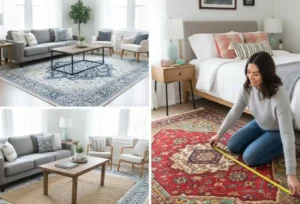A well-chosen rug can transform your space — but only if it complements your walls and furniture. The right rugs and carpets bring balance, warmth, and texture to a room. Whether you’re designing a cozy living area or a modern lounge, harmony between color, texture, and style is key. Here’s a guide to help you match your rug with your wall colors and furniture like a professional interior designer.

1. Start with Your Color Palette
Before buying a rug, look at your room’s existing color scheme. The wall color and furniture tones should guide your choice.
-
Neutral walls (like beige, white, or gray) allow for bold rug designs. Try patterned rugs or rich hues such as navy, emerald, or rust.
-
Bold walls benefit from subtle, neutral rugs. A cream, tan, or light gray rug will balance the intensity.
-
Matching tones: Choose a rug that includes one or two shades from your wall or furniture for a cohesive look.
Pro tip: Use a color wheel to find complementary or analogous colors that naturally go together.
2. Match Textures and Materials
Texture plays as big a role as color in home décor. Soft, plush carpets add comfort to living rooms, while flatweave rugs bring elegance to modern spaces.
-
Combine matte-painted walls with shaggy or wool rugs for warmth.
-
Match sleek furniture finishes (like metal or glass) with low-pile rugs to maintain a clean aesthetic.
-
For natural wood tones, jute or sisal rugs enhance the organic look beautifully.
3. Balance Patterns and Prints
If your walls or furniture already have bold patterns, keep your rug simple. Conversely, a patterned rug adds depth to minimalist décor.
-
Solid furniture + patterned rug: Creates a vibrant focal point.
-
Patterned sofa + plain rug: Prevents visual overload.
-
Subtle geometric rugs pair beautifully with modern or Scandinavian styles.
Always ensure one element—rug, wall, or furniture—remains visually calm to achieve design balance.
4. Use Rug Size to Define Space
Even the perfect color match can fall flat if your rug is too small or too large.
-
Living room: The rug should extend under the front legs of sofas and chairs.
-
Bedroom: Leave 18–24 inches of rug visible around the bed.
-
Dining room: Ensure the rug extends beyond the chairs when pulled out.
A well-sized rug or carpet grounds the furniture and makes your space feel intentional and inviting.

5. Layer for Depth and Personality
Don’t be afraid to layer rugs! Combine a large neutral base rug with a smaller patterned one for added depth. This works especially well in open-concept areas where rugs can define different zones.
Layering also lets you mix textures—think of a wool rug over a jute base—to create warmth and sophistication.
FAQs
1. Should my rug match the wall color exactly?
No. Aim for complementary tones rather than an exact match to create depth and visual interest.
2. What color rug goes best with gray walls?
Warm shades like beige, blush, mustard, or navy pair beautifully with gray walls.
3. Can I mix patterns in rugs and furniture?
Yes, but keep one pattern subtle. A bold patterned rug pairs best with plain or lightly textured furniture.
4. Which rug color is most versatile?
Neutral tones like ivory, gray, and taupe are timeless and fit nearly every décor style.
5. Should I choose the rug before or after furniture?
If possible, choose your rug first—it sets the tone for the rest of your furniture and accessories.
Z”
